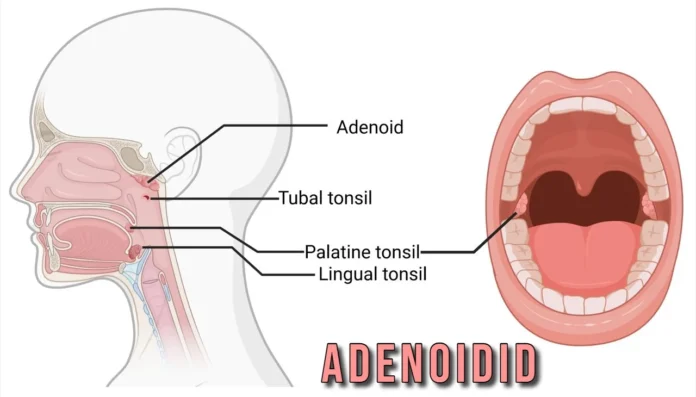Introduction
Adenoidid is a common but easily perplexing illness, particularly in children. As part of the lymphoid system, the adenoids play a vital role in the body’s defense against infection, particularly in early childhood. When these tissues get infected or inflamed, however, they develop a variety of unpleasant and sometimes dangerous symptoms. In this comprehensive article, we discuss everything you need to know about adenoiditis—from symptoms and etiology to new treatments and prevention.
What is Adenoidid?
Adenoidid refers to infection or inflammation of the adenoids, small lymphoid nodules located in the back of the nasal airway. They are part of the normal immune system and serve to filter viruses and bacteria. While adenoids are bigger in children, they normally shrink and become less effective during adolescence and adulthood.
If enlarged, the adenoids can obstruct nasal airflow, leading to breathing difficulties, snoring, and frequent infections.
Common Causes of Adenoidid
Adenoidid is primarily caused by bacterial or viral infection. A few of the most common culprits are:
- Streptococcus bacteria
- Influenza virus
- Adenovirus
- Epstein-Barr virus
- Rhinovirus
These germs can travel to the body through the mouth or nose and infect the adenoids, causing their enlargement and inflammation. In other instances, allergies also lead to adenoiditis.
Acute vs. Chronic Adenoiditis
Acute Adenoiditis
It tends to present acutely and most commonly with an upper respiratory infection. It may persist for several days to one week and is readily treatable with medicines.
Chronic Adenoiditis
Here, there is prolonged swelling over a long period of time, usually secondary to chronic infection or allergy. Chronic adenoiditis is not necessarily drug treatable and will typically have to be treated surgically.
Complications Associated with Adenoiditis
If left untreated, adenoiditis will cause severe health complications, predominantly in children. These include:
- Obstructive sleep apnea
- Recurrent middle ear infection (otitis media)
- Sinusitis
- Speech and developmental delay
- Malocclusion (crooked teeth)
- Hearing loss due to faulty Eustachian tubes
- Early diagnosis and treatment hinder such occurrences.
How is Adenoiditis Diagnosed?
Adenoiditis can be clinically and with diagnostic tests diagnosed. It is diagnosed based on general procedures that include:
Physical throat and neck examination
Nasal endoscopy for visualization of the adenoids
X-ray or imaging studies of nasopharynx
Swab test or throat culture for identifying bacterial infection
Blood tests to determine the existence of infection or inflammation
On some occasions, further testing with an ear, nose, and throat specialist is needed.
Optimal Treatments for Adenoiditis
Treatment of adenoiditis is cause-related, long-term, or severity-based. Adenoiditis may be treated with:
1. Medications
Antibiotics: Oral antibiotics are the most commonly used treatment in cases with bacterial etiology.
Analgesics: Over-the-counter ibuprofen or acetaminophen can be bought to reduce fever and pain.
Decongestants and nasal sprays: They may provide temporary relief for stuffy nose.
2. Supportive Care and Home Remedies
Steam inhalation to relieve nasal congestion
Saline nasal lavage to blow out mucus
Rest and fluids to boost immune system
Humidifiers to enable body to retain water in air and alleviate throat dryness
3. Surgical Treatment – Adenoidectomy
In chronic or recurring adenoiditis, adenoidectomy (removal of the adenoids) might be recommended.
Who Should Have an Adenoidectomy?
- Chronic adenoiditis in children
- Those with obstructive sleep apnea
- Those with recurrent ear or sinus infection
- Those with speech or hearing delay
Surgery is generally effective and safe, most often performed under general anesthesia on an outpatient basis.
Recovery and Postoperative Care
Healing for adenoidectomy is usually 1 to 2 weeks. Postoperative management involves:
Soft diet to prevent irritation in the throat
- Adequate intake of fluid
- Relief from pain with pain medicines administered
- Resting and avoiding strenuous physical activities for a few days
Follow-up visits must be done to check healing and avoid complications.
Prevention of Adenoidid
Prevention of Adenoidids cannot always be guaranteed, but certain habits help a great deal in reducing the risk:
Hand washing at regular intervals to avoid infection spread
Prevention of allergy and pollution
Protection of immunity through proper nutrition
Vaccination against recurrent respiratory infection
Prevention from secondhand smoke exposure
Treatment of adenoid and throat infection after they develop
When to Seek Medical Care
You should have your child examined by a doctor if:
- Your child continues to breathe with the mouth all the time
- The symptoms last longer than 10 days
- There are repeated bouts of Adenoidid
- There are indications of sleep apnea
- Ear infections continue to occur
Early diagnosis will prevent complications and improve the health of your child.
Living with Adenoidid: Long-Term Prospects
In children, Adenoidid in the majority is reversible and will recover once treated or operated on. Adenoidid can be prevented from recurring with cleanliness and proper care. In adults, although rare, Adenoidid may be an indicator of a more complex underlying condition and therefore must be extensively evaluated.
Conclusion:
Adenoidid may seem like a mild disease but is a bad disturbing factor in the development and health of a child unless treated properly. Proper treatment, early diagnosis, and preventive measures are necessary steps for appropriate management of the disease. Appropriate treatment is feasible in patients of all ages through medical as well as surgical management.
